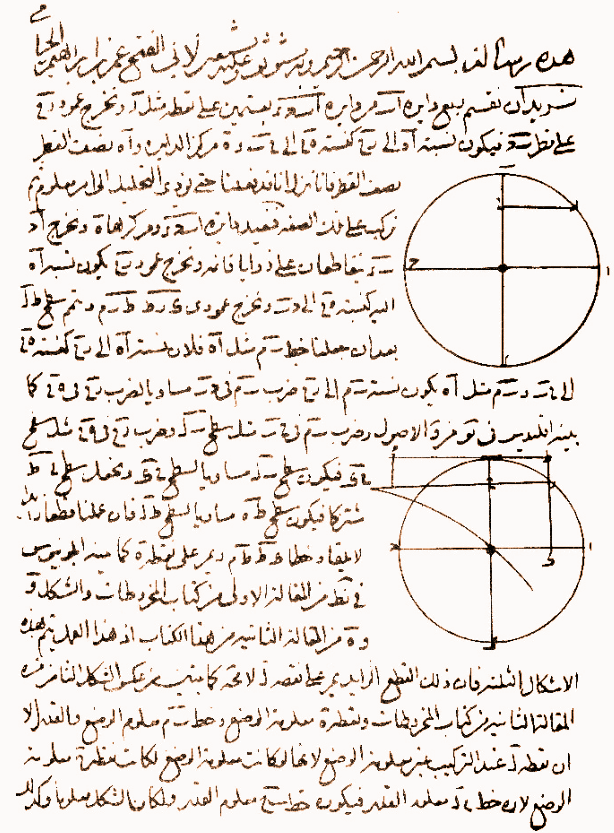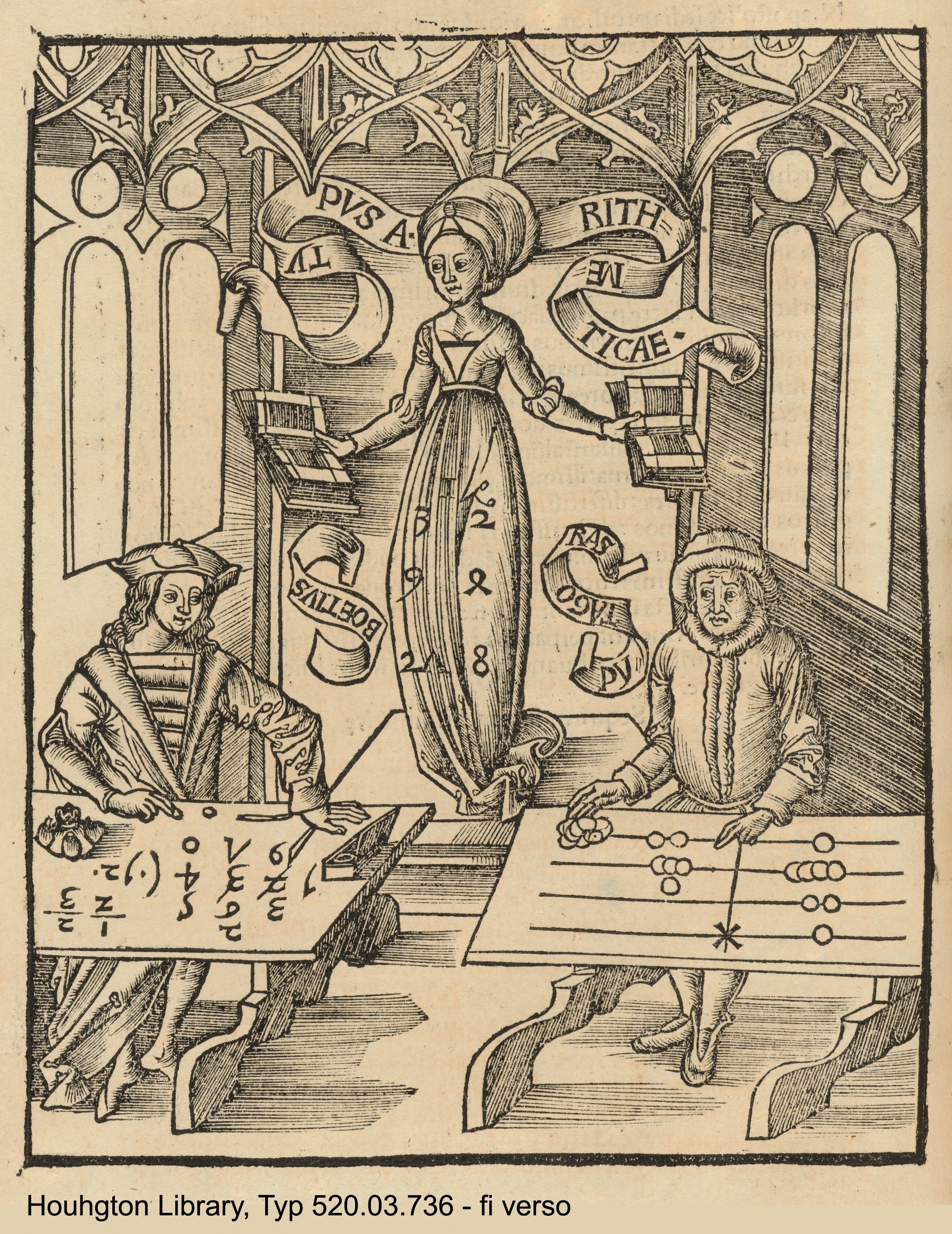|
Mathematics In The Medieval Islamic World
Mathematics during the Golden Age of Islam, especially during the 9th and 10th centuries, was built upon syntheses of Greek mathematics (Euclid, Archimedes, Apollonius) and Indian mathematics (Aryabhata, Brahmagupta). Important developments of the period include extension of the place-value system to include decimal fractions, the systematised study of algebra and advances in geometry and trigonometry. The medieval Islamic world underwent significant developments in mathematics. Muhammad ibn Musa al-Khwārizmī played a key role in this transformation, introducing algebra as a distinct field in the 9th century. Al-Khwārizmī's approach, departing from earlier arithmetical traditions, laid the groundwork for the arithmetization of algebra, influencing mathematical thought for an extended period. Successors like Al-Karaji expanded on his work, contributing to advancements in various mathematical domains. The practicality and broad applicability of these mathematical metho ... [...More Info...] [...Related Items...] OR: [Wikipedia] [Google] [Baidu] |
Al-Khwarizmi
Muhammad ibn Musa al-Khwarizmi , or simply al-Khwarizmi, was a mathematician active during the Islamic Golden Age, who produced Arabic-language works in mathematics, astronomy, and geography. Around 820, he worked at the House of Wisdom in Baghdad, the contemporary capital city of the Abbasid Caliphate. One of the most prominent scholars of the period, his works were widely influential on later authors, both in the Islamic world and Europe. His popularizing treatise on algebra, compiled between 813 and 833 as '' Al-Jabr'' (''The Compendious Book on Calculation by Completion and Balancing''),Oaks, J. (2009), "Polynomials and Equations in Arabic Algebra", ''Archive for History of Exact Sciences'', 63(2), 169–203. presented the first systematic solution of linear and quadratic equations. One of his achievements in algebra was his demonstration of how to solve quadratic equations by completing the square, for which he provided geometric justifications. Because al-Khwarizmi was ... [...More Info...] [...Related Items...] OR: [Wikipedia] [Google] [Baidu] |
Astronomy
Astronomy is a natural science that studies celestial objects and the phenomena that occur in the cosmos. It uses mathematics, physics, and chemistry in order to explain their origin and their overall evolution. Objects of interest include planets, natural satellite, moons, stars, nebulae, galaxy, galaxies, meteoroids, asteroids, and comets. Relevant phenomena include supernova explosions, gamma ray bursts, quasars, blazars, pulsars, and cosmic microwave background radiation. More generally, astronomy studies everything that originates beyond atmosphere of Earth, Earth's atmosphere. Cosmology is a branch of astronomy that studies the universe as a whole. Astronomy is one of the oldest natural sciences. The early civilizations in recorded history made methodical observations of the night sky. These include the Egyptian astronomy, Egyptians, Babylonian astronomy, Babylonians, Greek astronomy, Greeks, Indian astronomy, Indians, Chinese astronomy, Chinese, Maya civilization, M ... [...More Info...] [...Related Items...] OR: [Wikipedia] [Google] [Baidu] |
Mathematics
Mathematics is a field of study that discovers and organizes methods, Mathematical theory, theories and theorems that are developed and Mathematical proof, proved for the needs of empirical sciences and mathematics itself. There are many areas of mathematics, which include number theory (the study of numbers), algebra (the study of formulas and related structures), geometry (the study of shapes and spaces that contain them), Mathematical analysis, analysis (the study of continuous changes), and set theory (presently used as a foundation for all mathematics). Mathematics involves the description and manipulation of mathematical object, abstract objects that consist of either abstraction (mathematics), abstractions from nature orin modern mathematicspurely abstract entities that are stipulated to have certain properties, called axioms. Mathematics uses pure reason to proof (mathematics), prove properties of objects, a ''proof'' consisting of a succession of applications of in ... [...More Info...] [...Related Items...] OR: [Wikipedia] [Google] [Baidu] |
Diophantine Equation
''Diophantine'' means pertaining to the ancient Greek mathematician Diophantus. A number of concepts bear this name: *Diophantine approximation In number theory, the study of Diophantine approximation deals with the approximation of real numbers by rational numbers. It is named after Diophantus of Alexandria. The first problem was to know how well a real number can be approximated ... * Diophantine equation * Diophantine quintuple * Diophantine set {{disambig ... [...More Info...] [...Related Items...] OR: [Wikipedia] [Google] [Baidu] |
Numerical Analysis
Numerical analysis is the study of algorithms that use numerical approximation (as opposed to symbolic computation, symbolic manipulations) for the problems of mathematical analysis (as distinguished from discrete mathematics). It is the study of numerical methods that attempt to find approximate solutions of problems rather than the exact ones. Numerical analysis finds application in all fields of engineering and the physical sciences, and in the 21st century also the life and social sciences like economics, medicine, business and even the arts. Current growth in computing power has enabled the use of more complex numerical analysis, providing detailed and realistic mathematical models in science and engineering. Examples of numerical analysis include: ordinary differential equations as found in celestial mechanics (predicting the motions of planets, stars and galaxies), numerical linear algebra in data analysis, and stochastic differential equations and Markov chains for simulati ... [...More Info...] [...Related Items...] OR: [Wikipedia] [Google] [Baidu] |
Number Theory
Number theory is a branch of pure mathematics devoted primarily to the study of the integers and arithmetic functions. Number theorists study prime numbers as well as the properties of mathematical objects constructed from integers (for example, rational numbers), or defined as generalizations of the integers (for example, algebraic integers). Integers can be considered either in themselves or as solutions to equations (Diophantine geometry). Questions in number theory can often be understood through the study of Complex analysis, analytical objects, such as the Riemann zeta function, that encode properties of the integers, primes or other number-theoretic objects in some fashion (analytic number theory). One may also study real numbers in relation to rational numbers, as for instance how irrational numbers can be approximated by fractions (Diophantine approximation). Number theory is one of the oldest branches of mathematics alongside geometry. One quirk of number theory is ... [...More Info...] [...Related Items...] OR: [Wikipedia] [Google] [Baidu] |
Al-Karaji
(; c. 953 – c. 1029) was a 10th-century Persian mathematician and engineer who flourished at Baghdad. He was born in Karaj, a city near Tehran. His three principal surviving works are mathematical: ''Al-Badi' fi'l-hisab'' (''Wonderful on calculation''), ''Al-Fakhri fi'l-jabr wa'l-muqabala'' (''Glorious on algebra''), and ''Al-Kafi fi'l-hisab'' (''Sufficient on calculation''). Work Al-Karaji wrote on mathematics and engineering. Some consider him to be merely reworking the ideas of others (he was influenced by Diophantus) but most regard him as more original, in particular for the beginnings of freeing algebra from geometry. Among historians, his most widely studied work is his algebra book ''al-fakhri fi al-jabr wa al-muqabala'', which survives from the medieval era in at least four copies. He expounded the basic principles of hydrology and this book reveals his profound knowledge of this science and has been described as the oldest extant text in this field. He syst ... [...More Info...] [...Related Items...] OR: [Wikipedia] [Google] [Baidu] |
Latin
Latin ( or ) is a classical language belonging to the Italic languages, Italic branch of the Indo-European languages. Latin was originally spoken by the Latins (Italic tribe), Latins in Latium (now known as Lazio), the lower Tiber area around Rome, Italy. Through the expansion of the Roman Republic, it became the dominant language in the Italian Peninsula and subsequently throughout the Roman Empire. It has greatly influenced many languages, Latin influence in English, including English, having contributed List of Latin words with English derivatives, many words to the English lexicon, particularly after the Christianity in Anglo-Saxon England, Christianization of the Anglo-Saxons and the Norman Conquest. Latin Root (linguistics), roots appear frequently in the technical vocabulary used by fields such as theology, List of Latin and Greek words commonly used in systematic names, the sciences, List of medical roots, suffixes and prefixes, medicine, and List of Latin legal terms ... [...More Info...] [...Related Items...] OR: [Wikipedia] [Google] [Baidu] |
Quadratic Equation
In mathematics, a quadratic equation () is an equation that can be rearranged in standard form as ax^2 + bx + c = 0\,, where the variable (mathematics), variable represents an unknown number, and , , and represent known numbers, where . (If and then the equation is linear equation, linear, not quadratic.) The numbers , , and are the ''coefficients'' of the equation and may be distinguished by respectively calling them, the ''quadratic coefficient'', the ''linear coefficient'' and the ''constant coefficient'' or ''free term''. The values of that satisfy the equation are called ''solution (mathematics), solutions'' of the equation, and ''zero of a function, roots'' or ''zero of a function, zeros'' of the quadratic function on its left-hand side. A quadratic equation has at most two solutions. If there is only one solution, one says that it is a double root. If all the coefficients are real numbers, there are either two real solutions, or a single real double root, or two comple ... [...More Info...] [...Related Items...] OR: [Wikipedia] [Google] [Baidu] |
Diophantus
Diophantus of Alexandria () (; ) was a Greek mathematician who was the author of the '' Arithmetica'' in thirteen books, ten of which are still extant, made up of arithmetical problems that are solved through algebraic equations. Although Joseph-Louis Lagrange called Diophantus "the inventor of algebra" he did not invent it; however, his exposition became the standard within the Neoplatonic schools of Late antiquity, and its translation into Arabic in the 9th century AD and had influence in the development of later algebra: Diophantus' method of solution matches medieval Arabic algebra in its concepts and overall procedure. The 1621 edition of ''Arithmetica'' by Bachet gained fame after Pierre de Fermat wrote his famous " Last Theorem" in the margins of his copy. In modern use, Diophantine equations are algebraic equations with integer coefficients for which integer solutions are sought. Diophantine geometry and Diophantine approximations are two other subareas of number theo ... [...More Info...] [...Related Items...] OR: [Wikipedia] [Google] [Baidu] |
Al-Jabr
''The Concise Book of Calculation by Restoration and Balancing'' (, ;} or ), commonly abbreviated ''Al-Jabr'' or ''Algebra'' (Arabic: ), is an Arabic mathematical treatise on algebra written in Baghdad around 820 by the Persian polymath Al-Khwarizmi. It was a landmark work in the history of mathematics, with its title being the ultimate etymology of the word "algebra" itself, later borrowed into Medieval Latin as . ''Al-Jabr'' provided an exhaustive account of solving for the positive roots of polynomial equations up to the second degree. It was the first text to teach elementary algebra, and the first to teach algebra for its own sake. It also introduced the fundamental concept of "reduction" and "balancing" (which the term ''al-jabr'' originally referred to), the transposition of subtracted terms to the other side of an equation, i.e. the cancellation of like terms on opposite sides of the equation. The mathematics historian Victor J. Katz regards ''Al-Jabr'' as the first t ... [...More Info...] [...Related Items...] OR: [Wikipedia] [Google] [Baidu] |








